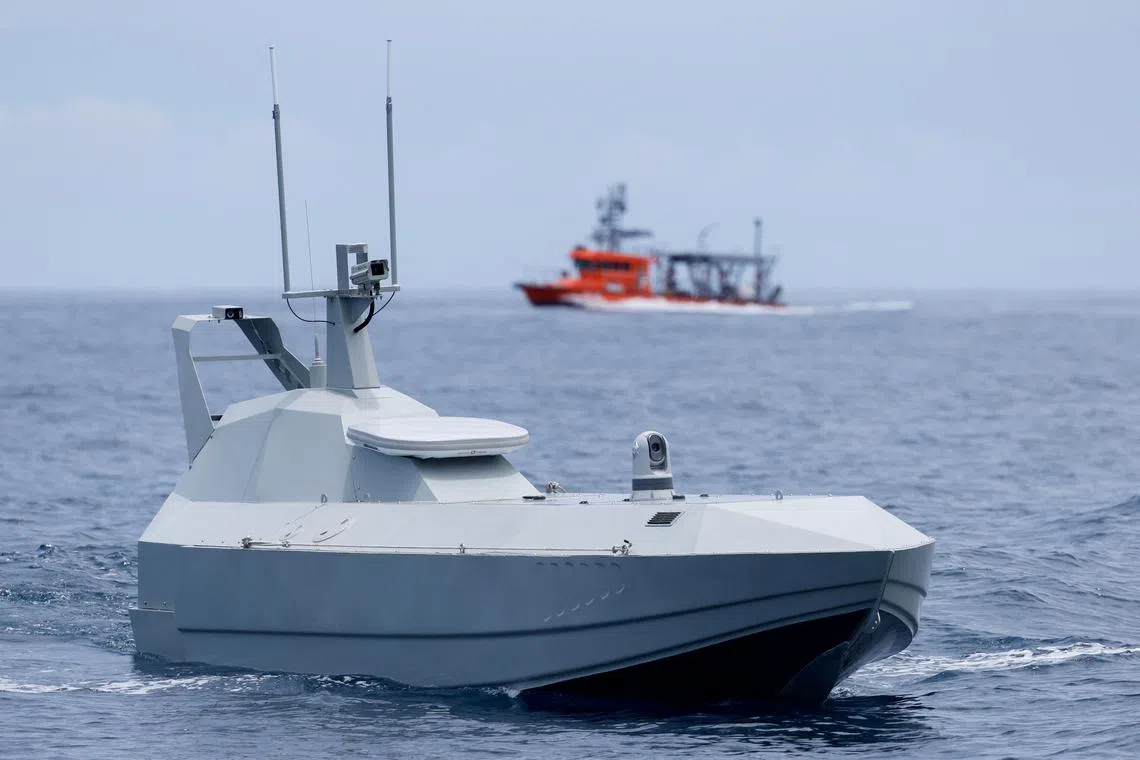Learning lessons from Ukraine, Taiwan eyes sea drones to counter China
Sign up now: Get insights on Asia's fast-moving developments

A SeaShark 800 sea drone, developed by Thunder Tiger, taking part in a test ride in the sea off Wushi, Taiwan, on June 6.
PHOTO: REUTERS
Follow topic:
WUSHI, Taiwan – Just off the small fishing port of Wushi on Taiwan’s Pacific coast, a Taiwanese company is testing what could eventually be a powerful but unglamorous new weapon in the island’s military arsenal – sea drones.
Taiwan is learning lessons on how it could use sea drones, used to great effect by Ukraine in the Black Sea against Russia, as an effective and low-cost way to fend off any possible Chinese invasion.
These drones are uncrewed, remotely controlled small vessels that are packed with explosives and can be guided towards ships or potentially even attack targets in the air.
Pushed by the US, Taiwan has been working to transform its armed forces to be able to wage “asymmetric warfare”, using mobile, smaller and often cheaper weapons that still pack a targeted punch, like sea drones.
“Uncrewed boats or vehicles have played a very significant role in the Ukraine war,” said Mr Chen Kuan-ting, a lawmaker for Taiwan’s ruling Democratic Progressive Party, who sits on Parliament’s foreign affairs and defence committee.
“Uncrewed vehicles, whether they are boats or underwater vehicles, can effectively deter China because Taiwan is not the attacking side, we are the defending side,” he told Reuters.
The Defence Ministry’s research and development arm, the National Chung-Shan Institute of Science and Technology, has termed the sea drone plan the “Swift and Sudden” project, which so far has a modest budget of around NT$800 million (S$34.7 million).
Defence Minister Wellington Koo said on June 11 that sea drones would be included in an additional spending package to be unveiled later in 2025. Details of that special budget have yet to be announced.
Mr William Chen, chairman of the Thunder Tiger company, told Reuters last week on a boat off Wushi – while viewing a test of their SeaShark 800 sea drone – that these new weapons present an element of surprise for China. They can carry 1,200kg of explosives and travel up to 500km.
“We can create uncertainty. We can fill the Taiwan Strait with danger and risks. No one knows where these dangers could surface,” he added.

Sea drones are uncrewed, remotely controlled small vessels that are packed with explosives and can be guided towards ships or potentially even attack targets in the air.
PHOTO: REUTERS
Sea drone show
Next week, Thunder Tiger will be among 12 Taiwanese and foreign companies joining an exhibition just down the coast from Wushi arranged by the Defence Ministry to showcase unmanned surface vehicles that may end up being added to Taiwan’s arsenal.
Other companies taking part, according to the ministry, include Taiwan navy contractor Lungteh Shipbuilding and US military shipbuilder Huntington Ingalls Industries.
“Drones are a top priority for both the United States and Taiwan. Obviously the conflict in Ukraine is focusing minds on what the next generation of warfare will look like,” said Mr Rupert Hammond-Chambers, president of the US-Taiwan Business Council, who is leading a US defence industry delegation to Taiwan this week, including drone makers.
China views democratically governed Taiwan as its own territory and has ramped up its military pressure over the past five years, including staging half a dozen rounds of war games. Taiwan’s government rejects Beijing’s sovereignty claims.
Since Russia invaded Ukraine in 2022, Taiwan has been studying how Ukraine has deployed drones to successfully offset Russia’s advantage on the battlefield and has enlisted commercial drone companies, including Thunder Tiger, to help.
Ukraine has deployed sea drones not only to attack ships in Russia’s Black Sea fleet, but also to shoot down aircraft.
Taiwan’s navy is dwarfed by that of China with its aircraft carriers and ballistic missile submarines, though China lacks recent combat experience.
China’s last successful large-scale amphibious assault was in 1950 when it seized Hainan island at the tail end of the Chinese Civil War, with troops ferried across on junks.
Mr Peter Chen, a drone expert and executive director of Taiwan security think-tank TTRDA, said Taiwan can undoubtedly make world-class sea drones.
“But when it comes to the application, how to turn them into top-notch weapons, it is not the responsibility of private companies. The views of the government and the military on how to properly integrate the weapons into the battle strategy, that needs more thinking,” he said.
REUTERS

